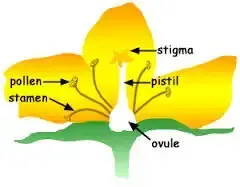POLLINATION AND FERTILIZATION IN PLANTS
Visit a flower garden in the summer and you’ll see and hear lots of activity.
Bees are buzzing and busily moving from flower to flower. Butterflies are quieter, but they’re visiting the flowers too. Ladybugs crawl and fly about. If
you’re lucky, you might even see a hummingbird or two. What’s going on here? Why is everyone so busy? These animals are attracted to nectar in the flowers.
Nectar is a sweet liquid deep inside a flower. It provides food for bees, butterflies and even bats. These animals need nectar to grow, and also to lay
eggs. Plants help animals, but the animals are helping the plants too. When bees and other animals move around flowers, they take pollen, which forms on the male
part of the flowers, the anthers, and move it to the pistils, or female parts of the flowers. If the pollen lands in the right spot, it moves down through the pistils, to the eggs, which are inside the flower.
Fun Facts about Pollination and Fertilization of Plants for Kids Once the pollen meets the egg, a seed is formed. Seeds are usually formed in fruit. A berry is a
fruit, so is an apple. Even a pea or tomato is a fruit because they contain seeds. Once the fruit is mature, it releases the seeds. The seeds land on the
soil and create new plants. Seeds can’t get up and walk, of course, but they move away from the parent plant in many ways. By moving, they can grow in a
place where there’s enough water, nutrients and light. Seeds have many ways of moving. Sometimes the wind blows them about. When animals eat the berries, the
seeds come out in their poop. Some seeds, like cockleburs, attach to people and animals for a ride.
Parts of the Flower
Important Flower Parts for Pollination Process Pollination and Fertilization
Vocabulary
Nectar: sweet liquid in plants Pollen: powder or dust on flowers
Anther: male part of flower, which produces pollen
Pistil: female part of the flower, which moves pollen to the eggs
Fruit: plant part that holds seeds.
How Wind Pollination Works Image
Seeds have many ways of moving. Sometimes the wind blows them about, something amazing all about pollination and fertilization of Plants Learn More All About
Pollination and Fertilization of Plants Take a look at this interesting video all about pollination:
"https://youtu.be/78PzI9exMBo"
A video explaining the types and processes of pollination in plants. Pollination and Fertilization
Q&A
Question:What happens if a flower isn’t fertilized?
Answer: Sometimes a flower won’t receive pollen and develop seeds. Bees and other pollinators don’t come out in rainy, cold weather. Then the flower dies and drops, without producing seeds.
Question: Do all plants have both male and female flowers?
Answer: Some plants produce male and female flowers. Pumpkins and cucumbers, for example, have some flowers that are male and some that are female. The female flowers have a little bump at the base of the flower. This bump becomes a fruit if the flower is fertilized.
Author
Shaik Urwa Noorin.
A cycle 2&3 teacher with a passion for creating time-saving classroom resources. She enjoys sharing her attempt to juggle it all... grading papers, lesson planning, student referrals, parent communication, test prep, and so much more all while managing a busy home life with two active toddlers.
WELCOME
I'm Shaik Urwa Noorin a cycle 2&3 teacher, wife + busy mom trying to juggle it all! Some days are smooth sailing, but sometimes the guilt of not giving time to family and self-care + others are simply overwhelming!





Comments
Post a Comment